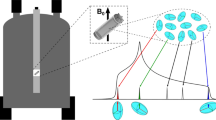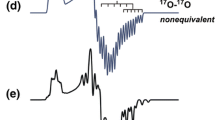Abstract
Nitroxide spin probes and spin labels are broadly utilized in EPR oximetry studies ranging from in vivo investigation to profiling heterogeneous environment of lipid bilayer membranes and proteins by site-specific oxygen-accessibility experiments. In such experiments, effective collision distances of the spin exchange interaction between the nitroxide and molecular oxygen are typically assumed to be the same even though localization of spin density over the nitroxide moiety is known to be affected by local polarity. Furthermore, some biophysical studies, such as those involving lipid bilayers, are often carried out with structurally different nitroxides but the results are analyzed under an assumption that proportionality between changes in the nitroxide electronic relaxation times and the product of the local oxygen concentration and translational diffusion coefficients remain the same. Here, we present an experimental verification of such a prevailing but not yet verified assumption by measuring effects of molecular oxygen in air and pure oxygen at atmospheric pressure on continuous wave EPR spectra of six structurally different nitroxides including those capable of reversible protonation. The data were analyzed using a convolution fitting model, which, by comparing EPR spectra measured at two different oxygen concentrations, allows one to extract the peak-to-peak width \({\Delta }B_{{{\text{p}} - {\text{p}}}}\) of a Lorentzian function that characterizes the effect of oxygen broadening. While the data on oxygen broadening measured by comparing EPR spectra of nitroxide solutions equilibrated with nitrogen and pure oxygen show clear trends that are rationalized by differences in the nitroxide structure, the overall variations in \({\Delta }B_{{{\text{p}} - {\text{p}}}}\) for various nitroxides fall within ca. ± 5%. Such variations are comparable to the effect of “salting-out” of molecular oxygen in aqueous solutions when electrolytes are present in physiological concentrations. Overall, the data further establish nitroxides as robust EPR molecular probes to measure the product of local oxygen concentration and its translational diffusion coefficient under a wide range of conditions such as pH and electrolyte concentrations.






Similar content being viewed by others
References
Y. Deguchi, Proton hyperfine spectra of diphenyl picryl hydrazyl. J. Chem. Phys. 32, 1584–1585 (1960)
K.H. Hausser, Über den Einfluß des gelösten Sauerstoffs auf die Linienbreite der Elektron-Spin-Resonanz in Lösung. Naturwissenschaften 47, 251–251 (1960)
R.B. Ingalls, G.A. Pearson, A basis for the determination of dissolved oxygen by electron spin resonance spectroscopy. Anal. Chim. Acta 25, 566–569 (1961)
M.J. Povich, Electron spin resonance oxygen broadening. J. Phys. Chem. 79, 1106–1109 (1975)
M.J. Povich, Measurement of dissolved oxygen concentrations and diffusion coefficients by electron spin resonance. Anal. Chem. 47, 346–347 (1975)
J.M. Backer, V.G. Budker, S.I. Eremenko, Y.N. Molin, Detection of kinetics of biochemical reactions with oxygen using exchange broadening in ESR spectra of nitroxide radicals. Biochim. Biophys. Acta 460, 152–156 (1977)
D.A. Windrem, W.Z. Plachy, The diffusion-solubility of oxygen in lipid bilayers. Biochim. Biophys. Acta 600, 655 (1980)
C.A. Popp, J.S. Hyde, Effects of oxygen on EPR spectra of nitroxide spin-label probes of model membranes. J. Magn. Reson. 43(1981), 249–258 (1969)
W.K. Subczynski, J.S. Hyde, The diffusion-concentration product of oxygen in lipid bilayers using the spin-label T1 method. Biochim. Biophys. Acta 643, 283–291 (1981)
W.K. Subczynski, J.S. Hyde, Concentration of oxygen in lipid bilayers using a spin-label method. Biophys. J. 41, 283–286 (1983)
T. Sarna, A. Dulȩba, W. Korytowski, H. Swartz, Interaction of melanin with oxygen. Arch. Biochem. Biophys. 200, 140–148 (1980)
K.J. Liu, P. Gast, M. Moussavi, S.W. Norby, N. Vahidi, T. Walczak, M. Wu, H.M. Swartz, Lithium phthalocyanine: a probe for electron paramagnetic resonance oximetry in viable biological systems. Proc. Natl. Acad. Sci. 90, 5438–5442 (1993)
A.I. Smirnov, S.W. Norby, T. Walczak, K.J. Liu, H.M. Swartz, Physical and instrumental considerations in the use of lithium phthalocyanine for measurements of the concentration of the oxygen. J. Magn. Reson. 103, 95–102 (1994)
A.I. Smirnov, S.-W. Norby, J.A. Weyhenmeyer, R.B. Clarkson, The effect of temperature on the respiration of cultured neural cells as studied by a novel electron paramagnetic resonance technique. Biochim. Biophys. Acta 1200, 205–214 (1994)
S.J. Boyer, R.B. Clarkson, Electron paramagnetic resonance studies of an active carbon: the influence of preparation procedure on the oxygen response of the linewidth. Colloids Surf. Physicochem. Eng. Aspects 82, 217–224 (1994)
H.M. Swartz, R.B. Clarkson, The measurement of oxygenin vivousing EPR techniques. Phys. Med. Biol. 43, 1957–1975 (1998)
A.A. Bobko, I. Dhimitruka, T.D. Eubank, C.B. Marsh, J.L. Zweier, V.V. Khramtsov, Trityl-based EPR probe with enhanced sensitivity to oxygen. Free Radic. Biol. Med. 47, 654–658 (2009)
T.I. Smirnova, A.I. Smirnov, Dynamic molecular oxygen accessibility to a buried Mn2+ protein site: a high-field EPR experiment. J. Phys. Chem. B 107, 7212–7215 (2003)
A.I. Smirnov, S.-W. Norby, R.B. Clarkson, T. Walczak, H.M. Swartz, Simultaneous multi-site EPR spectroscopy in vivo. Magn. Reson. Med. 30, 213–220 (1993)
O.Y. Grinberg, A.I. Smirnov, H.M. Swartz, High spatial resolution multi-site EPR oximetry—the use of a convolution-based fitting method. J. Magn. Reson. 152, 247–258 (2001)
V.O. Grinberg, A.I. Smirnov, O.Y. Grinberg, S.A. Grinberg, J.A. O’Hara, H.M. Swartz, Practical conditions and limitations for high-spatial-resolution multisite EPR oximetry. Appl. Magn. Reson. 28, 69 (2005)
J.S. Hyde, W.K. Subczynski, Spin-label oximetry, in Spin labeling: theory and applications. ed. by L.J. Berliner, J. Reuben (Springer, Boston, 1989), pp. 399–425
T.I. Smirnova, M.A. Voinov, A.I. Smirnov, Spin probes and spin labels, in Encyclopedia of Analytical Chemistry (John Wiley & Sons, Ltd, New York, 2006).
R. Ahmad, P. Kuppusamy, Theory, instrumentation, and applications of electron paramagnetic resonance oximetry. Chem. Rev. 110, 3212–3236 (2010)
C. Altenbach, T. Marti, H. Khorana, W. Hubbell, Transmembrane protein structure: spin labeling of bacteriorhodopsin mutants. Science 248, 1088–1092 (1990)
G.E. Fanucci, D.S. Cafiso, Recent advances and applications of site-directed spin labeling. Curr. Opin. Struct. Biol. 16, 644–653 (2006)
E. Bordignon, Site-directed spin labeling of membrane proteins, in EPR spectroscopy: applications in chemistry and biology. ed. by M. Drescher, G. Jeschke (Springer, Berlin, 2012), pp. 121–157
L.J. Berliner, J. Grunwald, H.O. Hankovszky, K. Hideg, A novel reversible thiol-specific spin label: Papain active site labeling and inhibition. Anal Biochem 119, 450–455 (1982)
H.S. McHaourab, M.A. Lietzow, K. Hideg, W.L. Hubbell, Motion of spin-labeled side chains in T4 lysozyme. Correlation with protein structure and dynamics. Biochemistry 35, 7692–7704 (1996)
A.I. Smirnov, A. Ruuge, V.A. Reznikov, M.A. Voinov, I.A. Grigor’ev, Site-directed electrostatic measurements with a thiol-specific pH-sensitive Nitroxide: differentiating local pK and polarity effects by high-field EPR. J. Am. Chem. Soc. 126, 8872–8873 (2004)
M.A. Voinov, A. Ruuge, V.A. Reznikov, I.A. Grigor’ev, A.I. Smirnov, Mapping local protein electrostatics by EPR of ph-sensitive thiol-specific nitroxide. Biochemistry 47, 5626–5637 (2008)
M.C. van Hemert, P.E.S. Wormer, A. van der Avoird, Ab initio calculation of the Heisenberg exchange interaction between O2 molecules. Phys. Rev. Lett. 51, 1167–1170 (1983)
O.H. Griffith, P.J. Dehlinger, S.P. Van, Shape of the hydrophobic barrier of phospholipid bilayers (Evidence for water penetration in biological membranes). J. Membr. Biol. 15, 159–192 (1974)
A.I. Smirnov, T.I. Smirnova, P.D. Morse, Very high-frequency electron-paramagnetic-resonance of 2,2,6,6-tetramethyl-1-piperidinyloxy in 1,2-dipalmitoyl-sn-glycero-3-phosphatidylcholine liposomes—partitioning and molecular dynamics. Biophys. J. 68, 2350–2360 (1995)
A.I. Smirnov, T.I. Smirnova, Resolving domains of interdigitated phospholipid membranes with 95 GHz spin labeling EPR. Appl. Magn. Reson. 21, 453–467 (2001)
T.I. Smirnova, A.I. Smirnov, High-field ESR spectroscopy in membrane and protein biophysics, in ESR Spectroscopy in Membrane Biophysics, ed. by M.A. Hemminga, L. J. Berliner (Springer, New York, 2007), pp. 165–251.
E. Bordignon, H. Brutlach, L. Urban, K. Hideg, A. Savitsky, A. Schnegg, P. Gast, M. Engelhard, E.J.J. Groenen, K. Möbius, H.-J. Steinhoff, Heterogeneity in the nitroxide micro-environment: polarity and proticity effects in spin-labeled proteins studied by multi-frequency EPR. Appl. Magn. Reson. 37, 391 (2009)
V.V. Khramtsov, L.B. Volodarsky, Use of imidazoline nitroxides in studies of chemical reactions ESR measurements of the concentration and reactivity of protons, thiols, and nitric oxide, in Biological magnetic resonance. ed. by L. Berliner (Plenum Press, New York, 2002), pp. 109–180
M.A. Voinov, I.A. Kirilyuk, A.I. Smirnov, Spin-labeled pH-sensitive phospholipids for interfacial pK(a) determination: synthesis and characterization in aqueous and micellar solutions. J. Phys. Chem. B 113, 3453–3460 (2009)
A.M. Alaouie, A.I. Smirnov, Ultra-stable temperature control in EPR experiments: thermodynamics of gel-to-liquid phase transition in spin-labeled phospholipid bilayers and bilayer perturbations by spin labels. J. Magn. Reson. 182, 229–238 (2006)
A.I. Smirnov, R.B. Clarkson, R.L. Belford, EPR linewidth (T-2) method to measure oxygen permeability of phospholipid bilayers and its use to study the effect of low ethanol concentrations. J. Magn. Reson. 111, 149–157 (1996)
T.I. Smirnova, A.I. Smirnov, R.B. Clarkson, R.L. Belford, Accuracy of oxygen measurements in T2 (Linewidth) EPR oximetry. Magn. Reson. Med. 33, 801–810 (1995)
A.I. Smirnov, Post-processing of EPR spectra by convolution filtering: calculation of a harmonics’ series and automatic separation of fast-motion components from spin-label EPR spectra. J. Magn. Reson. 190, 154–159 (2008)
A.I. Smirnov, R.L. Belford, Rapid quantitation from inhomogeneously broadened EPR spectra by a fast convolution algorithm. J. Magn. Reson 113, 65–73 (1995)
A.I. Smirnov, T.I. Smirnova, Convolution-based algorithm: from analysis of rotational dynamics to EPR oximetry and protein distance measurements, in EPR: instrumental methods. ed. by C.J. Bender, L.J. Berliner (Springer, New York, 2004), pp. 277–348
T.I. Smirnova, A.I. Smirnov, R.B. Clarkson, R.L. Belford, W-Band (95 GHz) EPR spectroscopy of nitroxide radicals with complex proton hyperfine structure: fast motion. J. Phys. Chem. 99, 9008–9016 (1995)
B.L. Bales, Inhomogeneously broadened spin-label spectra, in Spin labeling: theory and applications. ed. by L.J. Berliner, J. Reuben (Springer, Boston, 1989), pp. 77–130
Y.I. Glazachev, I.A. Grigor’ev, E.J. Reijerse, V.V. Khramtsov, EPR studies of 15N- and 2H-substituted pH-sensitive spin probes of imidazoline and imidazolidine types. Appl. Magn. Reson. 20, 489–505 (2001)
I.A. Kirilyuk, Y.F. Polienko, O.A. Krumkacheva, R.K. Strizhakov, Y.V. Gatilov, Y.V. Grigor’ev, E.G. Bagryanskaya, Synthesis of 2,5-bis(spirocyclohexane)-substituted nitroxides of pyrroline and pyrrolidine series, including thiol-specific spin label: an analogue of MTSSL with long relaxation time. J. Org. Chem. 77, 8016–8027 (2012)
A.F. Gulla, D.E. Budil, Orientation dependence of electric field effects on the g-factor of nitroxides measured by 220 GHz EPR. J. Phys. Chem. B 105, 8056–8063 (2001)
M.A. Voinov, A.I. Smirnov, Chapter Seven-Ionizable Nitroxides for Studying Local Electrostatic Properties of Lipid Bilayers and Protein Systems by EPR, in Methods in Enzymology, ed. by P.Z. Qin, K. Warncke (Academic Press, New York, 2015), pp. 191–217.
A.H. Cohen, B.M. Hoffman, Nitrogen-14 and oxygen-17 hyperfine interactions in perturbed nitroxides. J. Phys. Chem. 78, 1313–1321 (1974)
H. Miyamoto, Y. Yampolski, C.L. Young, IUPAC-NIST solubility data series .103. Oxygen and ozone in water, aqueous solutions, and organic liquids (supplement to solubility data series volume 7). J. Phys. Chem. Ref. Data 43, 033102 (2014)
J. Setschenow, Über die Konstitution der Salzlösungen auf Grund ihres Verhaltens zu Kohlensäure. Z. Phys. Chem. 4, 117–125 (1889)
H.L. Clever, Setchenov salt-effect parameter. J. Chem. Eng. Data 28, 340–343 (1983)
Acknowledgements
T.I.S. and A.I.S. are particularly thankful to Prof. H. M. Swartz who brought the subject of EPR oximetry with nitroxides to their attention back in the early 90s. This work was in part supported by U.S. DOE Contract DE-FG02-02ER15354 to A.I.S.
Author information
Authors and Affiliations
Corresponding author
Additional information
Publisher's Note
Springer Nature remains neutral with regard to jurisdictional claims in published maps and institutional affiliations.
Rights and permissions
About this article
Cite this article
Voinov, M.A., Smirnova, T.I. & Smirnov, A.I. EPR Oximetry with Nitroxides: Effects of Molecular Structure, pH, and Electrolyte Concentration. Appl Magn Reson 53, 247–264 (2022). https://doi.org/10.1007/s00723-021-01446-8
Received:
Revised:
Accepted:
Published:
Issue Date:
DOI: https://doi.org/10.1007/s00723-021-01446-8




